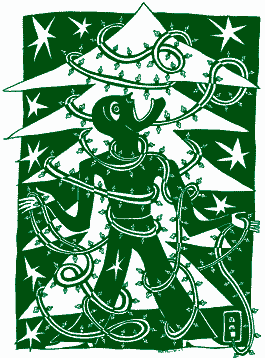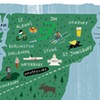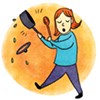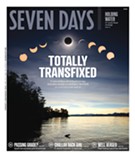Published December 12, 2001 at 4:00 a.m.
To tree, or not to tree? In homes like mine, where I am Jewish and my husband is not, that is the question. Our situation is hardly unique. According to recent estimates, fully one-third of married American Jews have non-Jewish spouses. Hallmark cashes in on this trend with a cheerful card showing a house with a Christmas tree displayed in one window and a Chanukah menorah in another. But for lots of families, accommodating this season’s competing claims isn’t quite as cut-and-dried as the card’s interfaith image might suggest.
In our case, for nearly two decades the Christmas tree question sat quietly in the corner of our marriage: always there, but never discussed. Since we always celebrated Christmas at the home of David’s parents, I could easily disavow the tree we trimmed there as belonging to the Christensens. And I was more than willing to do just that.
I preferred not to think about David’s modest desire for a tree, which paled beside his willingness to have a Jewish wedding and to give our children a Jewish education and my last name. Better not to remember the first year of our marriage — the only year we’ve ever stayed home for the holidays — when a beautifully bedecked evergreen brought the smell of winter into our Los Angeles apartment. Easier not to dwell on the realization that ever since the kids came along and I started feeling more seriously Jewish, the notion of a tree had been sitting less and less easily with me.
I never took the time to examine my tree aversion. But the longer I harbored it, the more attached to it I grew, and the gladder I was that geography and family were enabling me to keep it under wraps. I’d always assumed this respite would only last as long as David’s parents hosted us for Christmas. But the crisis that finally forced me to find out what the tree really meant to both of us was my mother’s final illness.
I’d flown to New Jersey to spend December taking care of her. I had left David and the kids in Vermont with eight sets of little packages, one for each night of Chanukah, and the assurance that they would follow what had become our family’s inalterable holiday itinerary — Christmas in Rochester with the Christensens, and New Year’s with the Horo-witzes in New Jersey. But two days after I arrived at my mother’s, David called to tell me his parents had offered to come to Vermont to help out while I was gone. And as long as everyone would already be together, it only made sense that they should celebrate Christmas there, in our house, with a tree.
His words galled me. Here I was, absorbed in the heartbreak of figuring out which foods might be smooth enough to slide past the tumor in my mother’s throat, and he was changing his plans in Vermont? Here I was worrying about unplugging my mother’s oxygen long enough to let her safely watch what would no doubt be her last Chanukah candles, and he was broaching a topic he knew I preferred to avoid? Crazy with self-pity, I heard his proposal as some sort of coup d’état — the very worst form of betrayal.
But to David, this adjustment in arrangements seemed only reasonable. While I panicked and fumed, he quietly and logically laid out his position, absolutely certain of the justice on his side. He reminded me of how far he, an adamant atheist, had come in accommodating my desire to raise our children — his children — in my religion. Compared to their four hours of Hebrew school each week, our daughter’s recent bat mitzvah and the Passover Seders we all celebrated together, the Christmas tree he would put up was really quite insignificant.
“It’s not a logical issue,” I told him. “It’s a gut issue. Will you explain to your parents how uncomfortable I am with the idea of having a tree in my house?”
I was hoping that once my in-laws understood the situation, they would veto the tree idea. But I also knew that even if they did, David would try to override their vote.
“If you do end up having a tree,” I said, “will you at least get rid of it before I come home? I don’t want to see it there.”
“Are you sure?” He sounded hurt. “I thought it would be sort of nice to leave your presents there, so they’d be waiting for you when you got home.”
For the briefest moment, I could almost taste the sweetness of his vision: his home; his tree; his family reunited; gifts for his wife. If I’d allowed myself to linger a little longer in the moment, I might have also understood why this image meant so much to him. Though David had been brought up without religion, his family did share some long-loved traditions, and one of their most treasured was Christmas. Our children, who had grown up spending Christmas with his parents, cherished this tradition as well.
“My parents have no objection to your lighting a menorah in their home,” David argued, his voice tense. “So why should you object to their having a tree in yours?”
“This is too much for me to think about right now,” I said.
What is a Christmas tree, anyway? Ancient Pagans observed the winter solstice with green branches symbolizing rebirth. Five hundred years ago, Germans started decorating their homes on Christmas Eve with “Paradise Trees” hung with apples representing sin, communion wafers signifying forgiveness and roses in remembrance of the Virgin Mary. To many devout Christians today, the Christmas tree connotes the cross. But for most Americans, including my very secular in-laws, a Christmas tree is merely a Christmas tree: fun to decorate, a pleasure to enjoy and a great centerpiece for exchanging gifts.
What the tree meant to the Horowitzes was a lot more complicated. The fact of the matter was that our adamantly Jewish family — like my mother’s adamantly Jewish family before us — celebrated Christmas. Every Christmas Eve, we hung our stockings. Every Christmas morning we awoke to a miracle of gifts. And every Christmas afternoon we tucked into roast beef and Yorkshire pudding, with wreath-shaped ice cream molds for dessert.
After my brother and sisters and I married and started spending Christmas with our non-Jewish in-laws, the Horowitz celebration of stockings and gifts and wreath-shaped ice cream molds shifted to New Year’s Day. We took to calling it, with some self-deprecation, “Fake Christmas.” But for all our Christmas exuberance, real or fake, we drew the line at public displays. We never strung lights on our house. We never hung a wreath on our door. And we never, ever had a tree.
“It seemed like a fair compromise,” my mother insisted the next morning, as we talked over the crisis in Vermont. “We did it for the children, so you wouldn’t feel deprived,” she explained.
But a tree? “A tree isn’t necessary,” she declared. “A tree makes a very strong statement about the identity of the household.”
What we did among ourselves was one thing. Just because we liked candy canes didn’t make us not-Jewish, or Christmas a Jewish holiday. But this nuance was likely to be lost on our neighbors. It was vital to demonstrate that everyone on our street wasn’t exactly alike — that our family, at least, had not been subsumed by the dominant culture.
For my parents especially, helping to raise the first generation of post-Holocaust Jews, being the only house on the block without Christmas lights was an act of defiance, a message to the world that centuries of persecution and murder and forced conversions hadn’t succeeded in wiping us out. That we weren’t trying to “pass” as non-Jews. That we weren’t the sort of people who considered our own long-beleaguered, minority religion so ritually impoverished that we had to go borrowing someone else’s traditions — although that was, in fact, exactly what we were doing, behind closed doors.
No doubt, an unstated sense of shame further fueled our anti-tree fervor. Maybe we had succumbed to this big, beautiful holiday. But did we also have to advertise the fact?
These were the rules with which I’d grown up. Being good meant abiding by them — or at least appearing to do so. I’d always been proud of the comfort my mother took in the Jewishness of my home, and I could see that David’s unexpected readiness to change the rules, now, struck her as a bad omen. Maybe we were raising her grandchildren as Jews while she was around to watch, she was thinking. But what might we do over her dead body?
As the day wore on, her position hardened. But as my panic receded and my thinking grew clearer, I moved oh-so-slowly the other way. As the grip of her anxiety began to release me, I started seeing David’s side of the story. I began to understand that a tree — which came so loaded with difficult and confusing implications for the Horowitzes — was, for the Christensens, simply evergreen and ornaments: beautiful, beloved and essential. What we were dealing with here, I finally realized, wasn’t some crafty encroachment on undefended territory. It was simply a variation in styles of celebration — just a bit of tinsel on a bough. Why should something so benign make everyone lose so much sleep?
When David called that evening, he was still indignant. He called my anti-tree attitude selfish, hypocritical and intolerant. But I was grateful when he told me that, in spite of all this, he and his parents understood how hard things were for us in New Jersey and didn’t want to add to our stress. So his parents would only stay in Vermont while the kids were in school, and then they’d all drive to Rochester for Christmas. The status quo would stand, for now. But David assured me, quite firmly, that this was only a temporary accommodation.
All this happened three years ago. Since then, the tree question has lost its former menace. Ironically, much of my new attitude has come from my growing certainty of myself as a Jew. Lighting Sabbath candles with my family on Friday night, leading prayers and reading Torah in the synagogue — things the Horo-witzes never did when I was growing up. I know who I am and don’t need the absence of a tree to remind me.
Though I can’t claim to be eager to put up a tree in our home, I know that David and I will share one. And the sweetness of that vision feels a lot more important than what the neighbors might think. If our tree confuses them about the nature of our home, they can always come inside and get to know us.
More By This Author
Comments
Comments are closed.
From 2014-2020, Seven Days allowed readers to comment on all stories posted on our website. While we've appreciated the suggestions and insights, right now Seven Days is prioritizing our core mission — producing high-quality, responsible local journalism — over moderating online debates between readers.
To criticize, correct or praise our reporting, please send us a letter to the editor or send us a tip. We’ll check it out and report the results.
Online comments may return when we have better tech tools for managing them. Thanks for reading.











































